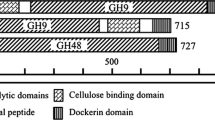Abstract
The synergistic action between Thermobifida fusca exocellulase Cel6B and endocellulase Cel5A on sodium hydroxide pretreated bacterial cellulose (BC) was determined. The activities of Cel6B and Cel5A were tested singly and both activities were dramatically increased on pretreated BC, especially in the early stage of hydrolysis. Cel5A, which attacks the cellulose chain randomly, showed a larger increase on NaOH treated BC than Cel6B. Mixtures of the two enzymes were also able to degrade NaOH treated BC faster than BC and the kinetics of the mixture differed from that of the individual enzymes. The degree of synergistic effect (DSE) on BC decreased dramatically with time of hydrolysis. However, the DSE on NaOH treated BC was almost constant throughout the incubation, with a smaller effect at higher NaOH concentrations. The change caused by NaOH did not increase the DSE, although each individual cellulase activity increased. This showed that synergistic activity was more effective on recalcitrant cellulose, which requires effective cooperation between the cellulase components for hydrolysis.




Similar content being viewed by others
References
Barr BK, Hsieh YL, Ganem B, Wilson DB (1996) Identification of two functionally different classes of exocellulases. Biochemistry 35:586–592
Ghose TK, Bisaria VS (1979) Studies on the mechanism of enzymatic hydrolysis of cellulosic substances. Biotechnol Bioeng 21:131–146
Irwin DC, Spezio ME, Walker LP, Wilson DB (1993) Activity studies of eight purified cellulases: specificity, synergism, and binding domain effects. Biotechnol Bioeng 42:1002–1013
Jeoh T, Walker LP, Wilson DB (2002) Cooperative and competitive binding in synergistic mixtures of Thermobifida fusca cellulases Cel5A, Cel6B, and Cel9A. Biotechnol Prog 18:760–769
Jeoh T, Wilson DB, Walker LP (2006) Effect of cellulase mole fraction and cellulose recalcitrance on synergism in cellulose hydrolysis and binding. Biotechnol Prog 22:270–277
Jeoh T, Ishizawa CI, Davis MF, Himmel ME, Adney WS, Johnson DK (2007) Cellulase digestibility of pretreated biomass is limited by cellulose accessibility. Biotechnol Bioeng 98:112–122
Jung ED, Lao G, Irwin DC, Barr BK, Benjamin A, Wilson DB (1993) DNA sequences and expression in Streptomyces lividans of an exoglucanase gene and an endoglucanase gene from Thermomonospora fusca. Appl Environ Microbiol 59:3032–3043
Jung H, Wilson DB, Walker LP (2002) Binding of Thermobifida fusca CDCel5A, CDCel6B and CDCel48A to easily hydrolysable and recalcitrant cellulose fraction on BMCC. Enz Microbial Technol 31:941–948
Kim YJ, Kim DO, Chun OK, Shin DH, Jung H, Lee CY, Wilson DB (2005) Phenolic extraction from apple peel by cellulases from Thermobifida fusca. J Agric Food Chem 53:9560–9565
Lever M (1972) A new reaction for colorimetric determination of carbohydrates. Anal Biochem 47:273–279
Linde M, Galbe M, Zacchi G (2006) Steam pretreatment of acid-sprayed and acid-soaked barley straw for production of ethanol. Appl Biochem Biotechnol 129–132:546–562
Mansfield SD, Meder R (2003) Cellulose hydrolysis—the role of component cellulases in crystalline cellulose degradation. Cellulose 10:159–169
Rezaeian M, Beakes GW, Chaudhry AS (2005) Relative fibrolytic activities of anaerobic rumen fungi on untreated and sodium hydroxide treated barley straw in in vitro culture. Anaerobe 11:163–175
SAS Institute, Inc. (1996) SAS user’s guide. SAS Institute Inc., Cary, NC
Sinitsyn AP, Mitkevich OV, Gusakov AV, Klyosov AA (1989) Decrease in reactivity and change of physico-chemical parameters of cellulose in the course of enzymatic hydrolysis. Carbohydr Res 10:1–14
Watson DL, Wilson DB, Walker LP (2002) Synergism in binary mixtures of Thermobifida fusca cellulases Cel6B, Cel9A, and Cel5A on BMCC and Avicel. Appl Biochem Biotechnol 101:97–111
Wilson DB (1992) Biochemistry and genetics of actinomycete cellulases. Crit Rev Biotechnol 12:45–63
Zhang S, Lao G, Wilson DB (1995) Characterization of a Thermomonospora fusca exocellulase. Biochemistry 34:3386–3395
Zhang S, Wilson DB (1997) Surface residue mutations which change the substrate specificity of Thermomonospora fusca endoglucanase E2. J Biotechnol 57:101–113
Acknowledgments
This work was supported by research a Grant (code #20050401034615) from BioGreen 21 Program, Rural Development Administration, Republic of Korea. Authors appreciate technical assistant from Diana Irwin in the Department of Molecular Biology and Genetics, Cornell University.
Author information
Authors and Affiliations
Corresponding author
Rights and permissions
About this article
Cite this article
Jung, H., Yoon, H.G., Park, W. et al. Effect of sodium hydroxide treatment of bacterial cellulose on cellulase activity. Cellulose 15, 465–471 (2008). https://doi.org/10.1007/s10570-007-9190-4
Received:
Accepted:
Published:
Issue Date:
DOI: https://doi.org/10.1007/s10570-007-9190-4




